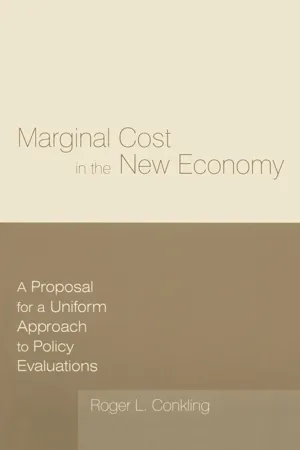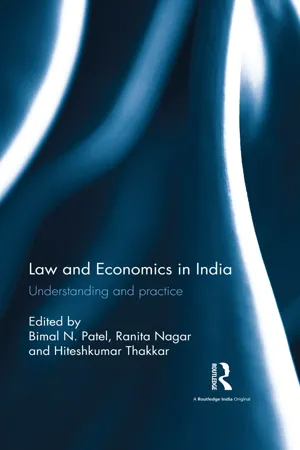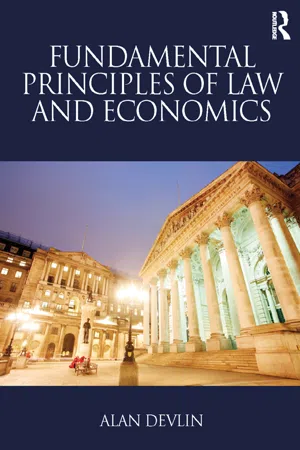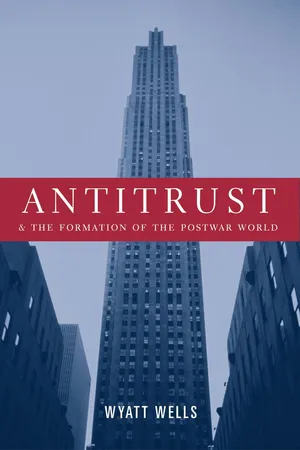Economics
Antitrust Law
Antitrust law refers to legislation designed to promote fair competition and prevent monopolistic practices in the marketplace. It aims to protect consumers by prohibiting activities such as price-fixing, bid-rigging, and other anti-competitive behaviors. Antitrust laws are enforced by government agencies to ensure that businesses operate within the boundaries of fair competition.
Written by Perlego with AI-assistance
Related key terms
6 Key excerpts on "Antitrust Law"
- eBook - ePub
- Thomas J. Miceli(Author)
- 2017(Publication Date)
- Stanford Economics and Finance(Publisher)
CHAPTER 10 THE ECONOMICS OF Antitrust LawThis chapter examines the economic justification for Antitrust Laws, the body of statutes and judicial rulings whose objective is to prevent anticompetitive business practices. Economists have long contributed to this area of law, leading many to label it as the “old” law and economics (as opposed to the “new” law and economics, which refers to the economic study of areas of law not explicitly concerned with markets—that is, the subject of the previous nine chapters of this book). Antitrust nevertheless remains a vigorous subfield of law and economics. This is true because, unlike many areas of law studied by economists, economic theory has much to contribute to our understanding of the efficient operation of markets.Of course, the starting point for any investigation of market regulation must be the Invisible Hand Theorem, which says that competitive markets, if left unregulated, will achieve an efficient allocation of resources. While this may suggest a laissez-faire attitude toward regulation, the conditions for perfect competition are rarely if ever met in practice. Thus, when significant departures from competition exist, whether through the efforts of a single firm, or a group of firms acting in concert, to exercise monopoly power, the resulting misallocation of resources may justify government intervention. This is the economic rationale for Antitrust Law.The literature on antitrust is vast, so this chapter offers only an overview of some of the key issues, with an emphasis on the insights economic theory can offer. We begin with a review of the economics of perfect competition, which provides a benchmark for measuring the efficiency losses due to monopoly. We then turn to the role of the law in promoting competition.1 Perfect Competition Versus MonopolyA monopoly - eBook - ePub
Marginal Cost in the New Economy: A Proposal for a Uniform Approach to Policy Evaluations
A Proposal for a Uniform Approach to Policy Evaluations
- Roger L. Conkling(Author)
- 2015(Publication Date)
- Routledge(Publisher)
In 1914, the year of the enactment of the Clayton Act, the Federal Trade Commission (FTC) was established to investigate “the organization, business conduct, practices and management” of companies in interstate commerce. The commission was instructed to challenge unfair methods of competition and any unfair or deceitful acts or practices of these companies. As a consequence, the Antitrust Laws are enforced by the FTC and the Antitrust Division of the Department of Justice, with the courts as the ultimate authority on contested issues.The genesis of the laws is explained in the 2001 joint DeLong-Summers paper:… political changes—the rise of antitrust—were needed for two reasons. The first was to try to make sure that the enormous economies of scale within the grasp of the large corporation were not achieved at the price of replacing competition by monopoly. The second was the political function of reassuring voters that the growing large corporations would be the economy’s servants rather than the voters’ masters.Twin PrinciplesThe laws clearly establish the twin principles that competition is good and monopoly is bad. They do not spell out the reasons why competition is good, however. The microeconomist is likely to suggest that the benefit of competition is that it leads to “competitive prices,” which are taken to be prices to consumers that are as low as practicable in a free economy. Monopoly, the absence of competition, may result in prices higher than they would be in a competitive market. Therefore, because of the price disadvantage to consumers, monopoly should be prevented in favor of competition. This line of reasoning suggests that the aim of the Antitrust Laws is to encourage a market environment that will induce low prices and discourage market conditions that may result in higher prices. If this is the aim of the laws, although unexpressed directly, then prices became a linchpin for antitrust judgments. Marginal costs, the subject of this book, point to the normative methodology, which could be a pattern for price evaluations. However, interpretations of the laws are complex and extend far beyond the narrow scope of this book, which focuses on the single element of cost/price determination. Leaving to others an examination of these other extensive elements of antitrust, this chapter is confined to a few observations. - eBook - ePub
Law and Economics in India
Understanding and practice
- Bimal N. Patel, Ranita Nagar, Hiteshkumar Thakkar(Authors)
- 2016(Publication Date)
- Routledge India(Publisher)
157 Further, in cases of mergers, having a merger simulation will have a substantial value. Developing counties such as India deal with varied problems. Some are distinct in their characteristics like high entry barrier (as in the case of cement) and public sector monopolies; the practices of abuse of dominant positions, cartelization and anti-competitive mergers are very much prevalent in India. Hence, there is a potential harm to economies. This chapter has looked into the international and national scenarios. The study of the international scenario is necessary because it will help combat and understand the competition issues in our country.Notes
1 M.M. Sharma, ‘Role of Economics in Competition Law’, accessed 14 August 2014, http://www.vaishlaw.com/article/RoleofEconomicsinCompetition%20Law-MMSharma.pdf .2 A. Kumar, ‘Competition Law at a Glance’, accessed 23 March 2014, http://cci.gov.in/images/media/articles/competition_lawglance_20080409115746.pdf.3 Paul Cook, ‘Competition and Its Regulation: Key Issues’, Annals of Public and Cooperative Economics 73 (2002): 541–558.4 Kumar, ‘Competition Law at a Glance’.5 Bingyuan Hsiung, ‘Economic Analysis of Law: An Inquiry of Its Underlying Logic’, Erasmus Law and Economics Review 2 (1) (2006): 1–33.6 Hugo L.C. Hazersloot, ‘Traditional Industrial Economics and Purchasing: A Theoretical Application of the SCP-Paradigm on Decision Points in Purchasing’, accessed 12 October 2014, http://www.utwente.nl/mb/ba/education/ba-thesis-2013-2/hazersloot.pdf .7 Richard A. Posner, ‘The Chicago School of Antitrust Analysis’, University of Pennsylvania Law Review 127 (4) (1979): 925–948.8 Hsiung, ‘Economic Analysis of Law’.9 William J. Kolasky and Andrew R. Dick, ‘The Merger Guidelines and the Integration of Efficiencies into Antitrust Review of Horizontal Mergers’, Antitrust Law Journal 71 (207) (2003), accessed 10 October 2014, http://www.justice.gov/atr/hmerger/11254.htm#N_1_ .10 Oliver E. Williamson, ‘Economies as an Antitrust Defense: The Welfare Tradeoffs’, American Economic Review 58 (1969): 18.11 U.S. v. Philadelphia National Bank , 374 U.S. 321 (1963); FTC v. Procter & Gamble Co. - eBook - ePub
- Alan Devlin(Author)
- 2014(Publication Date)
- Routledge(Publisher)
See Alan Devlin, ‘A proposed solution to the problem of tacit collusion in oligopolistic markets’ (2007) 59 Stan L Rev 1111.2 Nat’l Collegiate Athletic Ass’n v Bd. of Regents of Univ. of Oklahoma, 468 US 85 (1984).3 Ibid. at 101.4 Consten SA and Grundig Verkaufs-GmbH v Commission [1966] ECR 299.5 Leegin Creative Leather Prods, Inc v PSKS, Inc, 127 S Ct 2705 (2007).Passage contains an image Chapter 3 Monopolisation
Chapter ContentsA. Monopoly as an Elusive Prize: The Dilemma for Competition RegulatorsA. Monopoly as an Elusive Prize: The Dilemma for Competition RegulatorsB. Product TyingC. Anticompetitive PricingD. Refusals to DealE. Loyalty RebatesF. Vertical IntegrationKey Points References and Further ReadingG. Anticompetitive Mergers: Unilateral and Coordinated EffectsGiven the evil of monopoly, one might expect antitrust to attack the condition in all its forms. After all, if competitive markets tend toward efficiency, why would antitrust enforcers not break up dominant undertakings? Chapter 1 explored the industrial organisation literature, a portion of which suggests that firms in concentrated markets earn supracompetitive economic profits. Should structural remedies be the order of the day, restoring competition and lower prices for consumers? The answer is no.Dominance is itself perfectly lawful, as long as the monopolist neither achieves that position by predatory means nor artificially maintains it by exclusionary practices. This aspect of the law reflects a considered position. Although a structuralist view continues to hold sway in Europe, the Chicago and post-Chicago literature have diminished its influence. Instead, competition law polices dominate firm behaviour to ensure that it does not erect barriers to incumbent expansion and rival entry. This section explains these aspects of modern antitrust policy.1. Antitrust should rarely assail market structure - eBook - ePub
The Federal Trade Commission
A Guide to Sources
- Robert V. Larabee(Author)
- 2020(Publication Date)
- Routledge(Publisher)
Complicating Antitrust Law enforcement has been a number of contradictions and complexities that hinder a clear path for businesses to follow in order to avoid litigation. While Antitrust Laws clearly state certain guidelines and articulate easily applied rules, such as those related to price fixing and supplier boycotts, other areas of enforcement related to conglomerate mergers, oligopoly power, undue concentration, vertical integration, and dual distribution are “gray areas” that have yet to be resolved. It is noted that these issues are further complicated by the fact that the antitrust roles of the Department of Justice and the FTC have yet to be clearly differentiated.- 636 Elman, Philip. “Rulemaking Procedures in the FTC’s Enforcement of the Merger Law.” Harvard Law Review 78 (December 1964): 385–392.
Outlines the implications regarding the issuance by the FTC of a Trade Regulation Rule regarding vertical mergers in the cement industry. Of particular significance is the fact that this TRR represents an important departure from the traditional approach to enforcing Antitrust Laws based on judicial and quasi-judicial proceedings. The disadvantages of litigation on a case-by-case basis is also examined.- 637 Ely, R. S. “Work of the Federal Trade Commission.” Wisconsin Law Review7 (June 1932): 195–212.
Essay by an FTC staff member outlining the Commission’s history, duties and procedures employed with regard to its antitrust enforcement efforts and examines the agency’s present activities. The author concludes with an appraisal of the FTC’s work in response to President Herbert Hoover’s statements concerning the need for evaluating the existing Antitrust Laws.- 638 Elzinger, Kenneth G. “The Antimerger Law: Pyrrhic Victories?” Journal of Law and Economics 12 (1969): 42–78.
An examination of legal and economic literature as well as reaction in the business community to Antitrust Laws tends to point to a feeling of overexpansion of Section 7 of the Clayton Act as enforced by the FTC and Department of Justice. Given this expansion in Antitrust Law enforcement, this essay explores the issue of effective relief under the law and what happens after a merger has been found in violation of Antitrust Laws or the respondents have decided to submit to the consent order without further litigation. It is shown that without effective relief as a component of antimerger statutes competition will not be restored to the marketplace and the law will not prevent future mergers that could be harmful to competition. Specific Celler-Kefauver cases (listed as an appendix in the article) brought by the Department of Justice and the FTC under the legal standards of effective relief enforcement are analyzed to define what constitutes successful, sufficient, deficient or unsuccessful relief. - eBook - ePub
- Wyatt Wells(Author)
- 2001(Publication Date)
- Columbia University Press(Publisher)
2 The Context of AntitrustThe Antitrust TraditionAlone among industrial nations, the United States rejected cartels—at least in theory. Americans had been ambivalent toward big business ever since it emerged in the late nineteenth century, respecting its efficiency but fearing its economic and political power. These concerns led Washington to regulate the activities of large firms, outlawing cartels and imposing other restrictions on these companies. A few cartels did exist in the United States, but they were exceptions that participants usually justified by reference to special conditions. As a whole, Americans placed great confidence in economic competition as a check on the power of big business and looked askance at cartels.The Antitrust Laws, which largely banned cartels, had deep roots in the American political tradition. They evolved in the fifty years before World War II, shaped by a struggle between those who sought to break up large firms and those who believed that such companies offered economic advantages. By the 1930s, most in the United States took the Antitrust Laws for granted, considering them as part of an “American way” that tolerated big business but preserved a measure of competition among even the largest firms.For most Americans, the status of cartels was part of a larger constellation of issues involving the place of big business in society. During the late nineteenth century, the U.S. economy had changed radically. Before 1850, a complex network of independent merchants, most of whom employed no more than a handful of clerks and did business only in a limited geographic area, managed the flow of goods through the economy. The largest manufacturing companies, New England’s textile mills, each employed at most a few hundred workers. No firm had much control over its markets. On the whole, economic power, and the social and political power that went with it, was widely diffused. Slowly after 1850, and more rapidly after 1870, the situation changed. New technologies, particularly the development of the railroad, encouraged the growth of large, bureaucratic companies—big business. By 1900, these firms managed railways and telegraphs and dominated the production of steel, oil, copper, farm implements, electrical machinery, papers, cigarettes, soap, and more.1
Learn about this page
Index pages curate the most relevant extracts from our library of academic textbooks. They’ve been created using an in-house natural language model (NLM), each adding context and meaning to key research topics.





